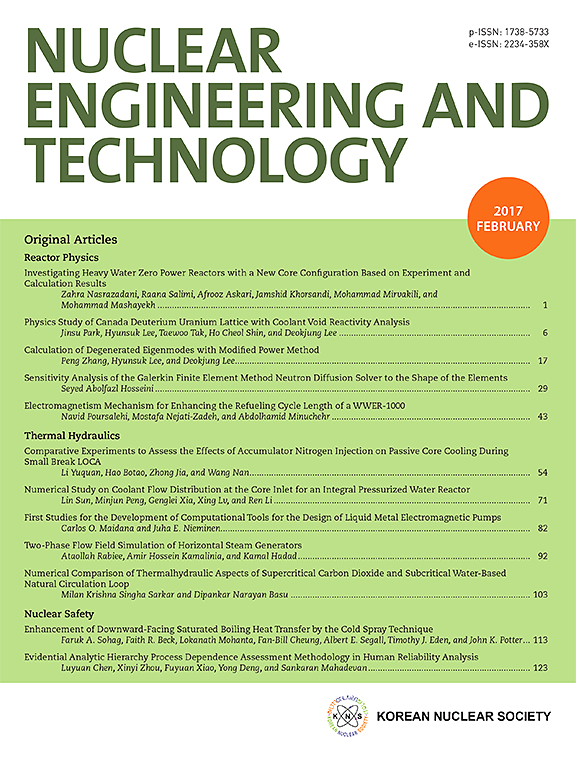Chlorination pathways of lanthanide and actinide oxides in LiCl-KCl molten salt: Electrochemical and spectroscopic studies
IF 2.6
3区 工程技术
Q1 NUCLEAR SCIENCE & TECHNOLOGY
引用次数: 0
Abstract
Pyroprocessing is a critical technology for recycling spent nuclear fuel, which enhances the sustainability of nuclear power generation. This process begins with metal oxides, which must be converted into metal chlorides to facilitate further processing, including electrorefining and electrowinning. In this work, we investigate the chlorination of lanthanide (Nd, Gd) and actinide (Th, Np) oxides in LiCl-KCl molten salt and confirm the chlorination through electrochemical and spectroscopic analyses. Nd2O3 and Gd2O3 are chlorinated using NH4Cl, with electrochemical measurements demonstrating the electrodeposition and dissolution currents of Nd3+ and Gd3+ ions. Th and Np chlorides are prepared using AlCl3 as a reactant. The reaction between ThO2 and AlCl3 produces ThCl4, as evidenced by the electrodeposition-dissolution currents of Th4+. For the chlorination of NpO2, NpO2Cl is first prepared by dissolving NpO2 in acidic solutions and then drying. Subsequently, the reaction of NpO2Cl and AlCl3 in molten LiCl-KCl yields NpCl4. Electrochemical and UV–Vis spectroscopic measurements confirm the redox reactions of Np4+/Np3+/Np0 and the presence of NpCl4 in the molten LiCl–KCl, respectively.
镧系和锕系氧化物在LiCl-KCl熔盐中的氯化途径:电化学和光谱研究
热处理是乏燃料循环利用的一项关键技术,可提高核能发电的可持续性。这个过程从金属氧化物开始,金属氧化物必须转化为金属氯化物,以便于进一步的加工,包括电精炼和电积。本文研究了镧系元素(Nd, Gd)和锕系元素(Th, Np)氧化物在LiCl-KCl熔盐中的氯化作用,并通过电化学和光谱分析证实了氯化作用。用NH4Cl氯化Nd2O3和Gd2O3,用电化学测量表明Nd3+和Gd3+离子的电沉积和溶解电流。以AlCl3为反应物制备了Th和Np氯化物。Th4+的电沉积-溶解电流证明了th2和AlCl3之间的反应生成ThCl4。对于NpO2的氯化,首先将NpO2溶解在酸性溶液中,然后干燥制备NpO2Cl。随后,NpO2Cl和AlCl3在熔融的LiCl-KCl中反应生成NpCl4。电化学和紫外可见光谱测量分别证实了熔融LiCl-KCl中存在Np4+/Np3+/Np0和NpCl4的氧化还原反应。
本文章由计算机程序翻译,如有差异,请以英文原文为准。
求助全文
约1分钟内获得全文
求助全文
来源期刊

Nuclear Engineering and Technology
工程技术-核科学技术
CiteScore
4.80
自引率
7.40%
发文量
431
审稿时长
3.5 months
期刊介绍:
Nuclear Engineering and Technology (NET), an international journal of the Korean Nuclear Society (KNS), publishes peer-reviewed papers on original research, ideas and developments in all areas of the field of nuclear science and technology. NET bimonthly publishes original articles, reviews, and technical notes. The journal is listed in the Science Citation Index Expanded (SCIE) of Thomson Reuters.
NET covers all fields for peaceful utilization of nuclear energy and radiation as follows:
1) Reactor Physics
2) Thermal Hydraulics
3) Nuclear Safety
4) Nuclear I&C
5) Nuclear Physics, Fusion, and Laser Technology
6) Nuclear Fuel Cycle and Radioactive Waste Management
7) Nuclear Fuel and Reactor Materials
8) Radiation Application
9) Radiation Protection
10) Nuclear Structural Analysis and Plant Management & Maintenance
11) Nuclear Policy, Economics, and Human Resource Development
 求助内容:
求助内容: 应助结果提醒方式:
应助结果提醒方式:


